How to Draw a Unicorn
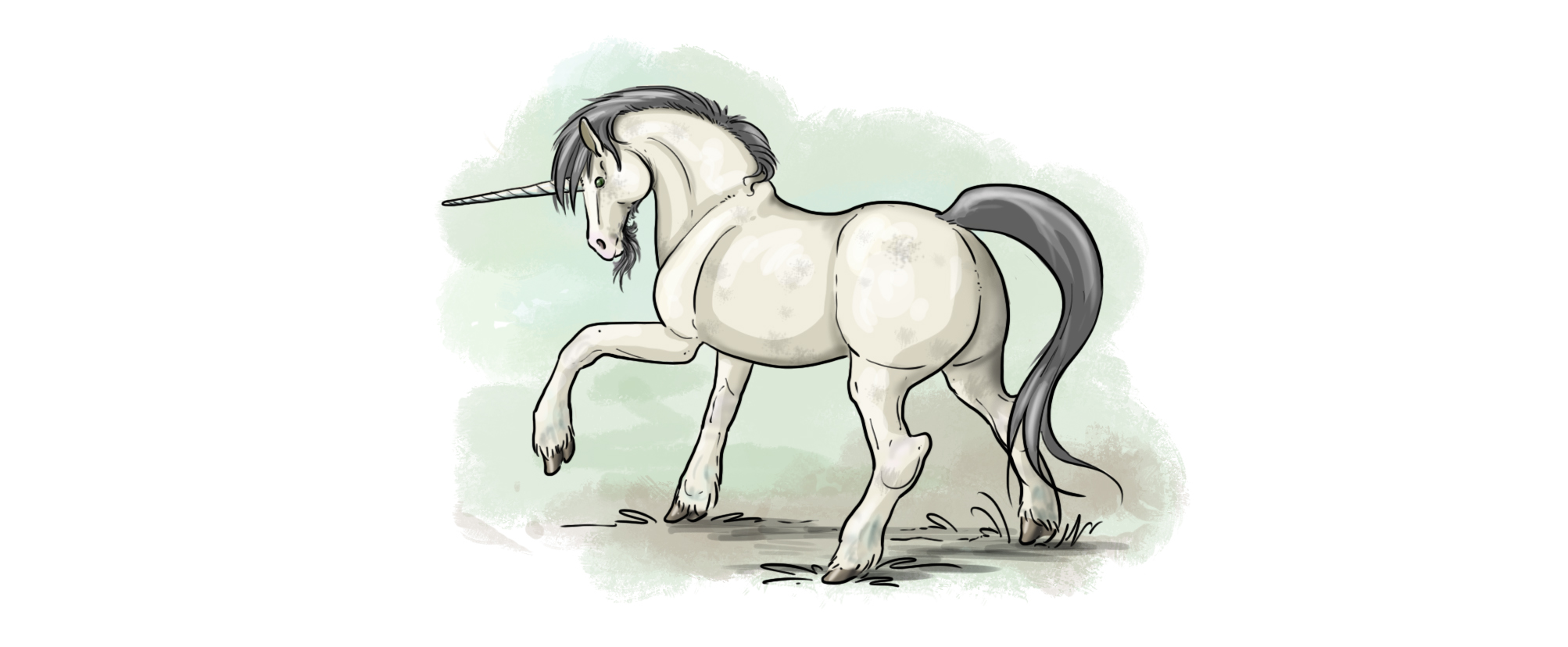
Today we enter the bestiary of myths and legends, we will spend a few moments in the company of unicorns! And although our subject is hard to observe in nature, it conforms to certain form codes that we will study.
THE LEGEND OF THE UNICORN
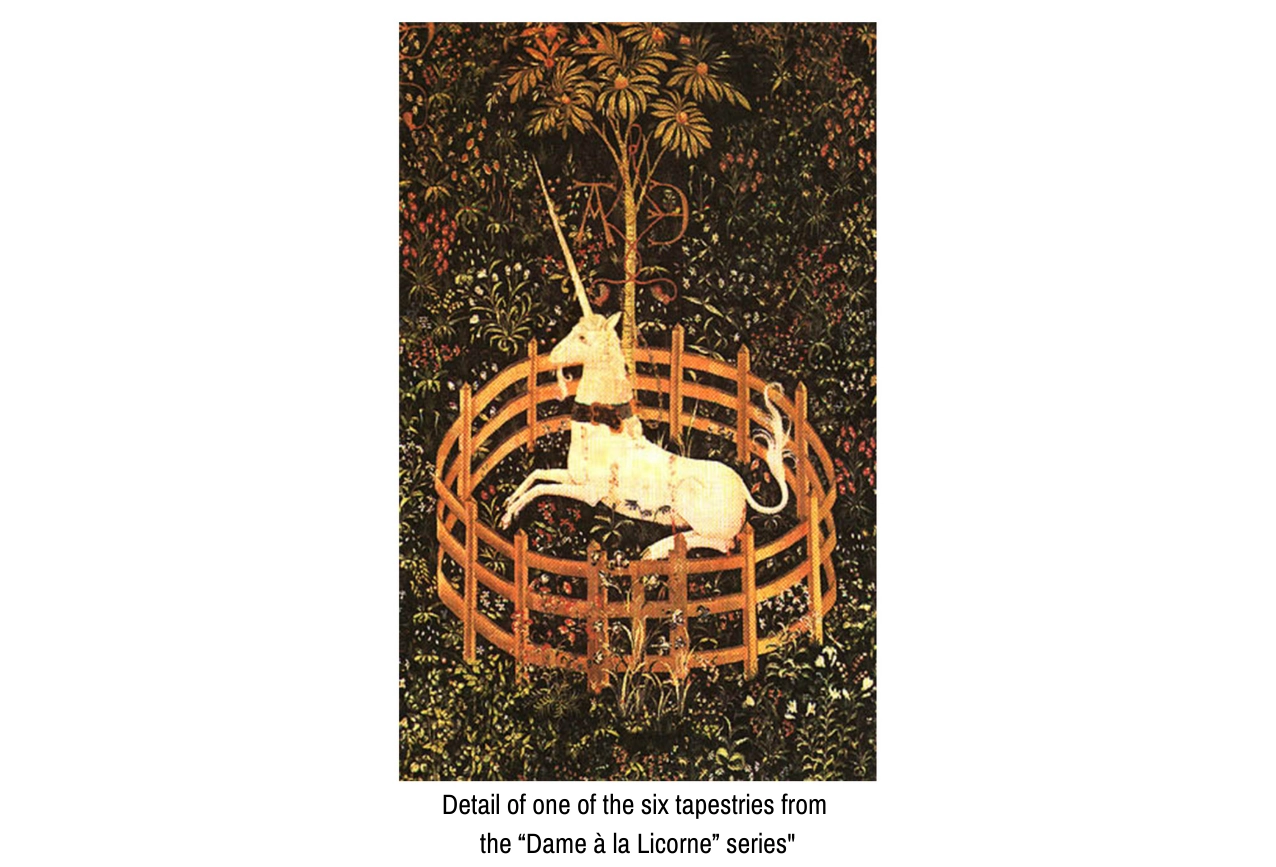
The origin of the unicorn myth is poorly defined, but it is more or less accepted that this animal is the result of reports from explorers who encountered various animals such as rhinoceroses or antelopes. It became a major creature in the imagination of the Christian West from the Middle Ages to the Renaissance. Indeed, it was toward the end of the Middle Ages that its form was settled between the horse (whose body it has) and the goat (preferably white, whose cloven hooves and beard it has), as shown in the detail of the tapestry above.
Of course, if you want to learn more about the origin of this creature, its evolution over time, and its symbolism, I strongly encourage you to find out more!
THE HORSE AS A BASIS FOR DRAWING THE UNICORN
So, as is commonly seen, the unicorn has a horse's body (sometimes it will actually have all its characteristics). Note that I really do mean "commonly," because, of course, the unicorn is a creature of imagination and you can make it your own by modifying its silhouette. So we're going to do a little "horse" overview. As this is not an article dedicated to horses, I won't go into too much detail. You can check our article for learning how to draw a horse if you want to know more!

Schema A
So the horse, like many animals, has the same leg structure as us. They have the same segments, just arranged differently. While we are plantigrade, the horse is a kind of digitigrade because it essentially walks on the tips of its toes.
On this diagram, you can also see the joints of the bones that, through their articulations, will impact the animal's silhouette (→ see the black arrows). At point 1, you will find a curve at the junction of these two bones. At point 2, the hip bone will create a small peak from which the line will descend to end in a tail. At point 3, the "knee" will be slightly protruding as at point 4, the ankle bone.

Diagram B: The masses
For the upper body, there is the head (triangular) in blue and the neck (long) in green.
For the rest of the body, there is the mass of the forelegs (in pink), the thigh, which is very developed and powerful (in purple), and the "bust" (in red). If you frame the muscles of the legs and the chest together, you get a fairly elongated rectangle [1]. If you then add the legs, you get a rectangle that is much less definite, almost square in appearance. You should note that the rectangle formed by the legs [2] is a bit higher than the rectangle with just the bust [1].
Schema C: We simplify
The head is a curved triangle with tips where we find, in 1, a circle formed by the mouth and nostrils and in 2, a slightly elongated circle formed by the animal's cheek.
The neck is a cone that gradually widens.
At the top of the front leg, the muscle mass can be simplified into a vaguely triangular shape, somewhat pear-shaped, on which we must not forget to mark junction 3!
The back gently slopes down from the top of the shoulders and rises to the "peak" of the hip at point 4. Note at point 5 that the tail is formed as an extension of the back line (it is an extension of the spine).
On the legs themselves, you will find two joints (represented by circles) on each limb.
Let's take some time to observe the head.

Schema A
Generally, the forehead is straight, but irregularities can be observed on the profile. First, at the level of the orbital arch, highlighted in pink, some breeds will have this area slightly curved (this is very noticeable in purebred Arabians); also the nostril area, above the lips, not resting on any bone, may be slightly "collapsed."
In blue, see how the ears are attached high on the head. In purple, a small curve suggests the tendons that serve as the axis to the ear. The ear will be quite pointed, and the folds will be visible on each side.
In green, the nostrils, which open along the length of the head, can be aligned with the eye.
In orange, notice how the neck does not quite start at the level of the bone and lets you change the volume of the lower jaw.
Schema B
The eye is positioned at the first quarter of the length of the head (light blue line), and although it is aligned with the nostril (green line), its axis of vision (orange line) intersects the forehead line at a fairly narrow angle.
The head forms the general shape of a triangle with curved tips (in dark blue) and there are two masses at the front, the nose/lips (in pink), and the cheeks (in purple).
In red, there is a small irregularity created by the lower lip.
In ¾ view and front view:

The general shape can now be formed (the "ball" with the nose at the tip (in pink) and the "ball" with the cheek on top (in purple) connect to form a soft triangle).
The eye and the nostril align on the green axis.
In red, the ears sit very high on the head.
THE UNICORN'S HOOVES
As we mentioned at the very beginning, the unicorn has often been depicted with goat hooves. I offer a quick reminder of the horse's hoof (you can choose to keep this characteristic of the horse if you so wish) as well as a depiction of the goat's hoof.
In both cases, do not forget the joint that finishes the leg (the purple circle). For humans, this is the joint before the first phalanx of the fingers and not the wrist.
The horse has a hoof made of one piece. Notice from the rear view how the structure is hollowed out in the middle.
The goat has a hoof split into two fairly independent parts. This structure allows the goat to have very good balance, which is essential for certain species (the mountain sheep, for example).

DRAWING WINGS?
If you want to be a little fancy, you might want to give your unicorn wings... Yes, it's very unusual, but why not?! So, here's a quick overview of wings!

Left drawing:
A bird's wing is composed of three bony segments and a fourth (4 in blue) consisting solely of feathers, which in reality is a continuation of segment 3.
Drawing on the right:
We can summarize the wing as having three layers of feathers. In blue, segment 1 is made up of feathers that follow and cover the bones. In green, segment 2 is made up of medium-sized feathers that follow the edge of segment 1. In purple and pink, segment 4 consists of more substantial feathers (larger and wider). This last segment can actually be divided into two sub-segments. Shown in purple at the end of the first half of the wing, the feathers are longer with tapered ends, and the area in pink is shorter with more squared feathers along the second half of the wing.
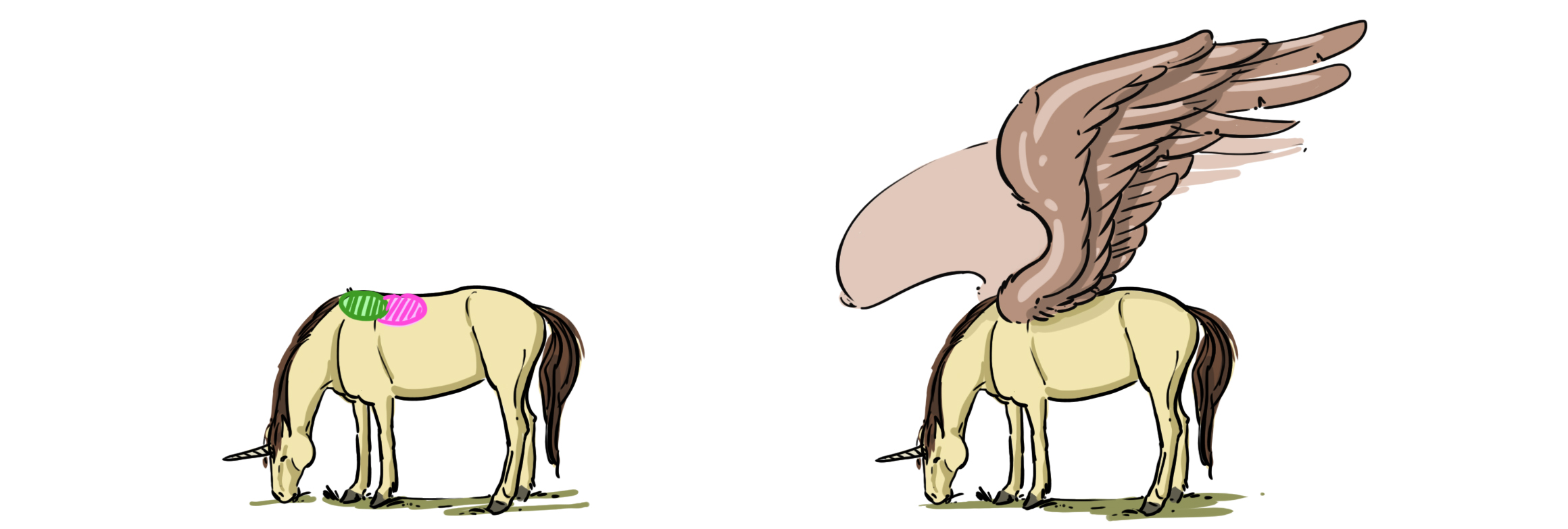
You should know that you have two choices available to you: either you fix your wing at the front leg, in the green zone, or you fix it just after, in the pink zone. For example, if you want a rider to mount your winged unicorn and sit with their legs in front of the wings, go for the pink option.
Here, for example, I attached the wings to the green area. An essential point: don’t skimp on the wingspan. Even if the animal is “magical,” it's hard to imagine it taking off with tiny wings.
DRAW THE HORN

Of course, you can opt for the classic (more or less) long, straight, and spiraled horn, like a narwhal [A]. But you can choose something curved with an appearance closer to that of a rhinoceros [B]. And while we're at it, although the unicorn is also called "unicorn," you can very well add another horn [C] and go for whatever shapes you like [C]!
DRAW A UNICORN STEP BY STEP
Well, as I've already told you in this article, today we are dealing with an imaginary animal (or not?! Okay, in any case, very very rare!) and so you can make your own choices! We are going to draw a unicorn, one among all possible unicorns, and you should not hesitate to have some fun with the shape of this animal.
I chose not to make my drawing too realistic. I am going for a very "horse-like" unicorn with goat hooves. The body will be seen from a ¾ rear view and the animal will slightly turn its head to be in profile.
Let's go...
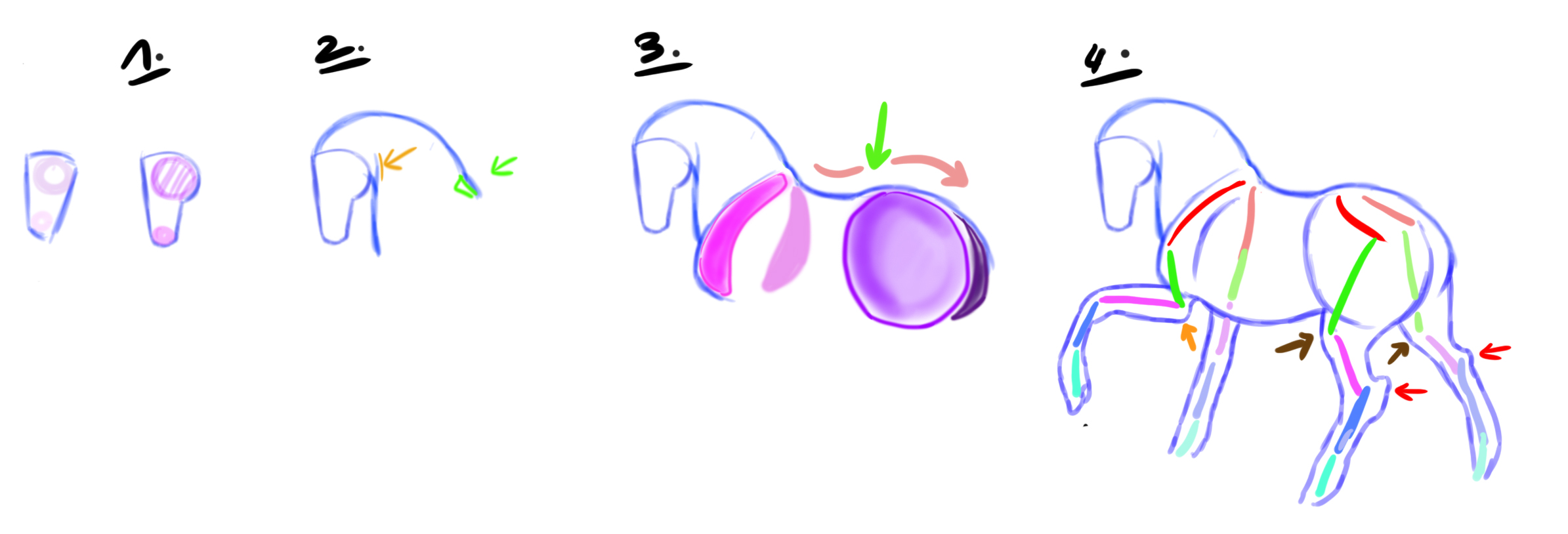
Step 1: Place the head, a triangle including the "ball" muzzle (nostril/lips) and the circle of the cheeks.
Step 2: Draw the neck, which gradually widens towards the neckline. The green arrow points to a small "bump" created by the shoulder. In orange, there is the fold of the neck under the lower jaw.
Step 3: Draw the back line that gently descends before heading towards the "tip" of the hip (green arrow) from which the back descends again (lines/red arrow). Place the "masses" of the muscles above the legs.
Step 4: Sketch some lines around the pink and purple masses from the previous step. Finish the belly. Roughly place the bones of the legs (see the color code used for the skeleton study). The "knees" will be shown in brown, the "ankles" in red, and the "elbow" in orange.
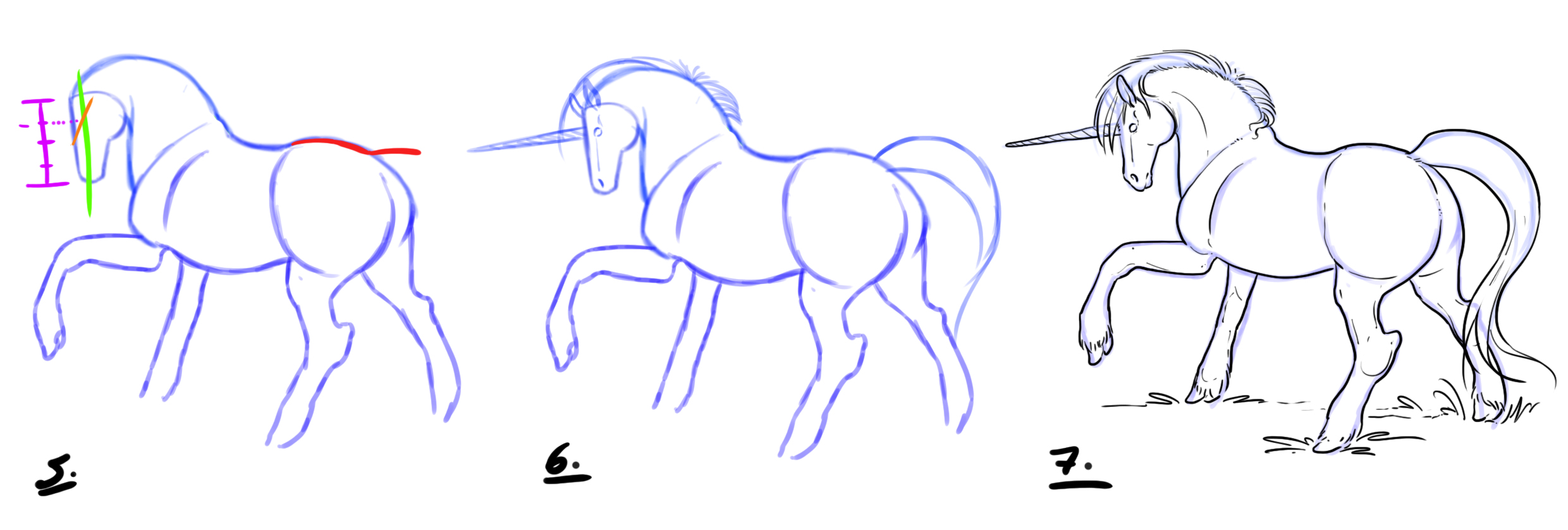
Step 5: The eye should be placed at the first quarter of the length of the head and aligned with the nostril (green line) but its axis should be at an inclined angle (orange line). Shown in red, extend the spine to position the tail.
Step 6: Draw the eye, trace the nostril and the mane, then place the horn on the top of the forehead.
Step 7: Based on the construction line, sketch the animal with a bit more detail and draw some details on the ground.
COLORING THE DRAWING
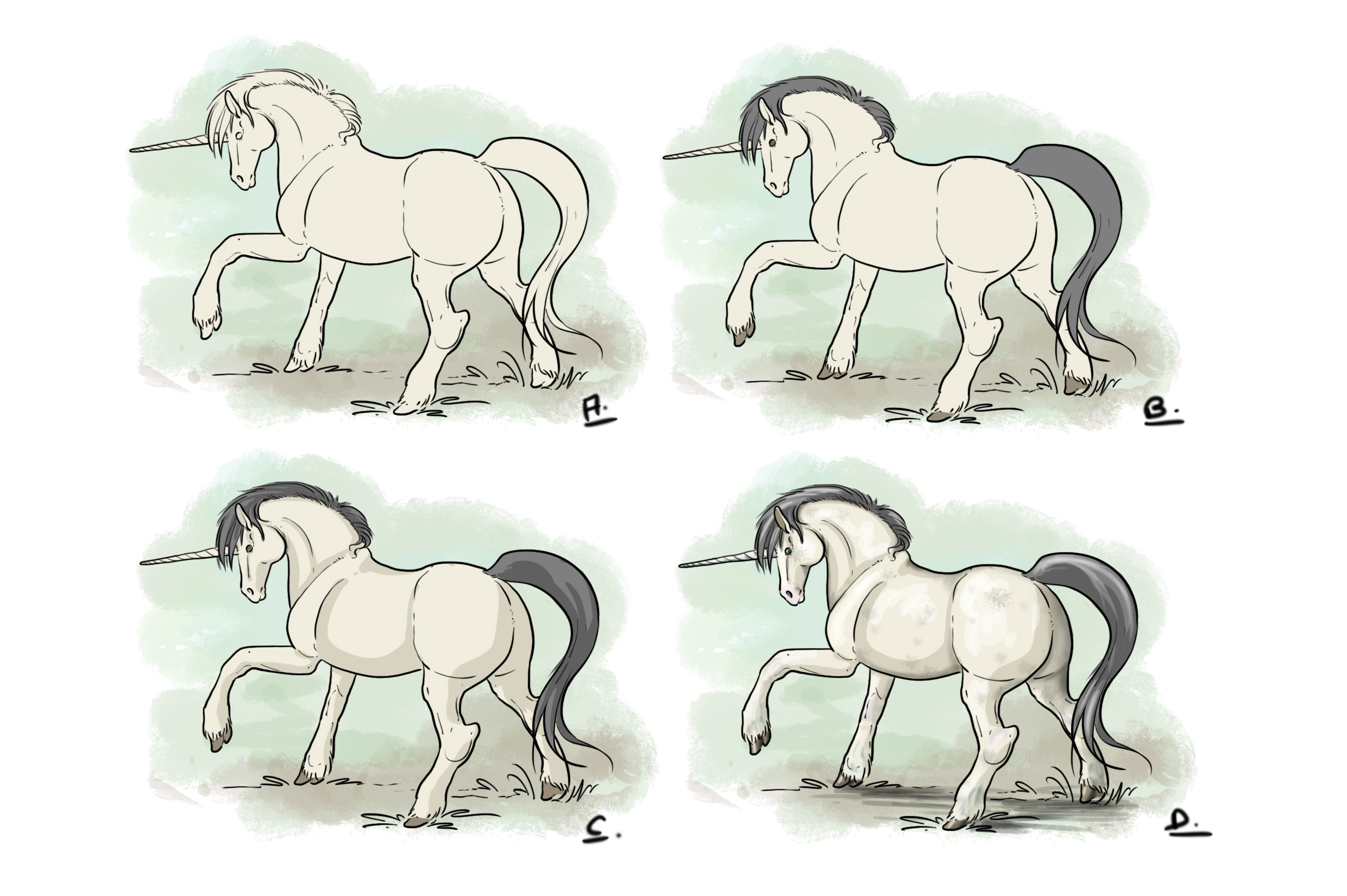
Stage A: The unicorn will have a very light coat, I chose an off-white, and to make it stand out a bit better, I quickly colored the background.
Step B: I chose a fairly neutral gray for the mane (mane and tail) and colored the hooves with a slightly grayish brown. I chose a dark green for the eye. I then decided that the horn would have the same base shade as the rest of the coat.
Stage C: I positioned the shadows related to the volumes; the light is soft and comes from the top left.
Step D: I added touches of white and gray to the body. I added some light on the mane, hooves, and eyes. I placed the shadows on the ground, the cast shadows, and enhanced the shadows on the hindquarters.
Note that I also decided to add a goat goatee.

And it's done!
Remember that you need to take a relaxed approach when drawing a unicorn. Have fun, whether it's with the shape of the horn, the colors, or the overall look! We are talking about a legendary animal, so there's nothing better than letting your imagination wander!
Illustrator and writer: Elo Illus

